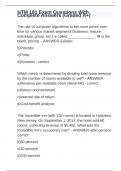Chapter 1: Financial management and value creation
Managers should manage their firms resources with the objective of increasing the firm values
Value creator
Who is going to finance your project?
Firms owners (shareholders) Equity capital
Debtholders (Bank) Debt capital
Capital employed = equity capital + debt capital
Capital is costly Cost of capital
The firm’s owner will find the project attractive only if its operating profitability exceeds the cost of
capital. Otherwise: Reduced firm value Unable to attract equity capital
Who is the owner of the firm?
Shareholder Residual claimants
Stakeholder customers, employees, people, etc.
If a project creates value, we accept it, but how to decide this?
NET PRESENT VALUE RULE
NPV = -Initial investment + Present value of Cash flows
Investors Project: Investors provide the initial cash
Project investors: The project generates future cash returns to investors
WEIGHTED AVERAGE COST OF CAPITAL
Wacc = Cost of equity x weight (equity) + cost of debt x (1-taks) x Weight (debt)
Applications of fundamental finance principle:
1) Capital budgeting decision
Whether an investment project should be accepted or not 2 decision tools:
Net present value rule A project should be undertaken if its NPV is positive or zero.
Internal rate of return rule (IRR) A project should be undertaken if its IRR is higher than, or
equal to, its cost of capital
Internal Return Rule: Measure of the firms operating probability
-It excludes the cost of financing, so commonly used in the analysis of the capital expenditures
-You must compare the projects IRR to the cost of financing the project (WACC)
2) The pay-out policy = When and how much cash the firm should distribute to its shareholders.
A firm generates money. What to do with this money?
1) Reinvest to another profitable project
,2) Pay-out. 2 forms of pay-out:
Dividends
-Cash dividend
-Stock dividend
Share repurchase
-Tender offers
-Open market
3) The capital structure decision
= How much of the firm’s asset should be financed with equity and how much with debt, to maximize
firm value. We don’t have 100% debt because of financial distress cost. As long as the present value
of the expected tax savings from debt financing is higher than the present value of the expected cost
of financial distress, additional borrowing will increase the firm’s value
4) The business acquisition decision =How much should be paid to acquire another company.
NPV (acquisition) = Premium paid to acquire the target company’s assets + PV of the post-acquisition
incremental net cash flows from the merged assets
Primary markets: Investors give cash to a firm and receive Newly issued securities
Intermarries (huwelijk aangaan) between individuals and institutions
Cash surplus of investors and cash deficit of firms are compensated by raising new capital
through the issuance of securities.
Investment bankers frequently involve to primary markets
Secondary markets: Investors give cash to a firm, and receive Outstanding securities
Efficient mechanism for trading outstanding (already issued) securities
Value creation determined by the security prices
Investment Banks use secondary market as benchmark for newly issued securities
How can firms finance their projects in primary markets?
Equity financing
-External Issue shares in the equity market
-Internal Retained Earnings
Debt financing (always external)
-Issue debt securities in the debt market
-Short term funds Commercial papers in money market
-Long term funds Bonds
Financial accounting process:
Balance sheet
Working Capital Requirement : Net investment that firm must make to support its production and
sales activities. WCR = (accountants Receivables + Inventory) – Accountants payable
Income statement
-First we pay to debt holders
-Then pay to tax authorities
-Residual claimant goes to equity holders
Where does cash come from?
,How profitable is the firm?
Profitability of equity capital
Profitability of invested capital
Sales less variable and fixed expenses Earnings before interest (EBIT)
EBIT less fixed interest expenses and variable tax expenses Earnings after tax (EAT)
Has the firm created value?
If ROIC > WACC creates value. If ROIC < WACC destroys value
The role of the Chief of Financial Officer (CFO)
-Treasury management; cash and currency management
-Planning; preparation of cash and capital budgets
-Accounting; record keeping, financial statements etc.
-Monitoring risk and controlling performance
-Taxation, tax optimizations
-Advising head of the company on investment, dividend policy, acquisitions etc.
Chapter 2: Time value of Money
Present value of cash flow streams
Perpetuities
Annuities
Growing perpetuities
Growing annuities
Interest rate quotation and calculation
, The effective annual rate(EAR): it indicates the actual amount of interest that will be earned at
the end of the year
Annual Percentage Rates (APR): the amount of simple interest earned in one year – that is, the
amount of interest earned without the effect of compounding.
Compound interest rate
Interest per period = R/periods a year
Changes in interest rates are usually quoted in terms of basis points. 1 basis point = 0.0001
Chapter 3: Risk and return
Measures of return
Measures of risk
Typically, risk is measured with the variance or variability (and standard deviation = square root of
the variance)
Mean variance analysis
-Risk averse: Investor’s decision will depends on his degree of risk-aversion
-Risk neutral: He likes higher expected returns an doesn’t care about risk
-Risk seeker: He likes higher expected returns as well as higher risk. Is ready to give up some
expected return in order to get more risk (gambler)
((Return-Expected return) /10)^2 = Squared deviation
Sum of squared deviations/numbers = variance
Standerd deviation = wortel van variance * 10
Computing portfolio expected returns











